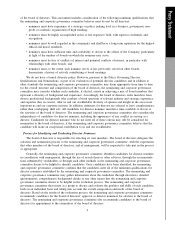iRobot 2009 Annual Report Download - page 21
Download and view the complete annual report
Please find page 21 of the 2009 iRobot annual report below. You can navigate through the pages in the report by either clicking on the pages listed below, or by using the keyword search tool below to find specific information within the annual report.
Proxy Statement
officers are generally targeted at the 50th percentile of similar cash incentives provided to officers in peer
companies reviewed by the compensation committee in the technology and robotics industries. The amount of
cash incentives paid to the named executive officers, however, is subject to the discretion of the compensation
committee based on its assessment of our performance in general or the achievement of specific goals.
For fiscal 2009, the target bonus awards under our Senior Executive Incentive Compensation Plan for
each of our named executive officers, as a percentage of base salary earned during the fiscal year, were 85%
for our chief executive officer, 65% for our chief financial officer, 65% for the president of our home robots
division, 65% for the president of our government & industrial robots division, and 50% for our senior vice
president and general counsel. These target payout amounts were set at levels the compensation committee
determined were appropriate in order to achieve our objective of retaining those executives who perform at or
above the levels necessary for us to achieve our business plan, which, among other things, involved growing
our company in a cost-effective way.
We designed our Senior Executive Incentive Compensation Plan to focus our executives on achieving key
corporate financial objectives and strategic milestones, and to reward substantial achievement of these
company financial objectives and strategic milestones. The 2009 performance goals and cash incentive
payment criteria established by the compensation committee under our Senior Executive Incentive Compensa-
tion Plan were designed to require significant effort and operational success on the part of us and our named
executive officers for achievement.
While the Senior Executive Incentive Compensation Plan is designed to provide cash incentive payments
based upon objectively determinable formulas that tie cash incentive payments to specific financial goals and
strategic milestones, the compensation committee retains the discretion to adjust cash incentive payments
under the Senior Executive Incentive Compensation Plan based upon additional factors.
For each executive officer, 100% of his target cash incentive compensation in 2009 was tied to key
financial and operating performance measures.
For our chief executive officer, chief financial officer, and senior vice president and general counsel, 75%
of the target cash incentive was tied to achieving an Adjusted EBITDA, excluding cash incentive compensation
expense, of $26.4 million, with the ability to earn 125% of the target cash incentive for this element by
achieving an Adjusted EBITDA, excluding cash incentive compensation expense, of $29.0 million. In addition,
25% of the target cash incentive was tied to achieving operating cash flow of $9.1 million, with the ability to
earn 125% of the target cash incentive for this element by achieving an operating cash flow of $10.0 million.
For our president, home robots, his target cash incentive had four elements:
• 25% of his target cash incentive was tied to achieving an Adjusted EBITDA, excluding cash incentive
compensation expense, of $26.4 million, with the ability to earn 125% of the target cash incentive for
this element by achieving an Adjusted EBITDA, excluding cash incentive compensation expense, of
$29.0 million.
• 15% of his target cash incentive was tied to achieving divisional revenue of $164.3 million, the ability
to earn 125% of the target cash incentive for this element by achieving divisional revenue of
$180.8 million.
• 50% of his target cash incentive was tied to achieving a target level of divisional contribution margin
with the ability to earn 125% of the target cash incentive for this element by achieving a divisional
contribution margin in excess of this target. Generally, contribution margin was calculated as division
specific revenue less cost of sales and operating expenses, excluding cash incentive and stock based
compensation. Since the specific contribution margin targets are highly confidential, we do not publicly
disclose these targets. Disclosing the contribution margin targets would provide competitors and other
third parties with insights into our internal confidential strategic and planning processes, sales and
marketing budgets and other confidential matters, which might allow our competitors to predict certain
business strategies, thereby causing competitive harm. The contribution margin targets were positioned
to be aggressive, but achievable.
19
























